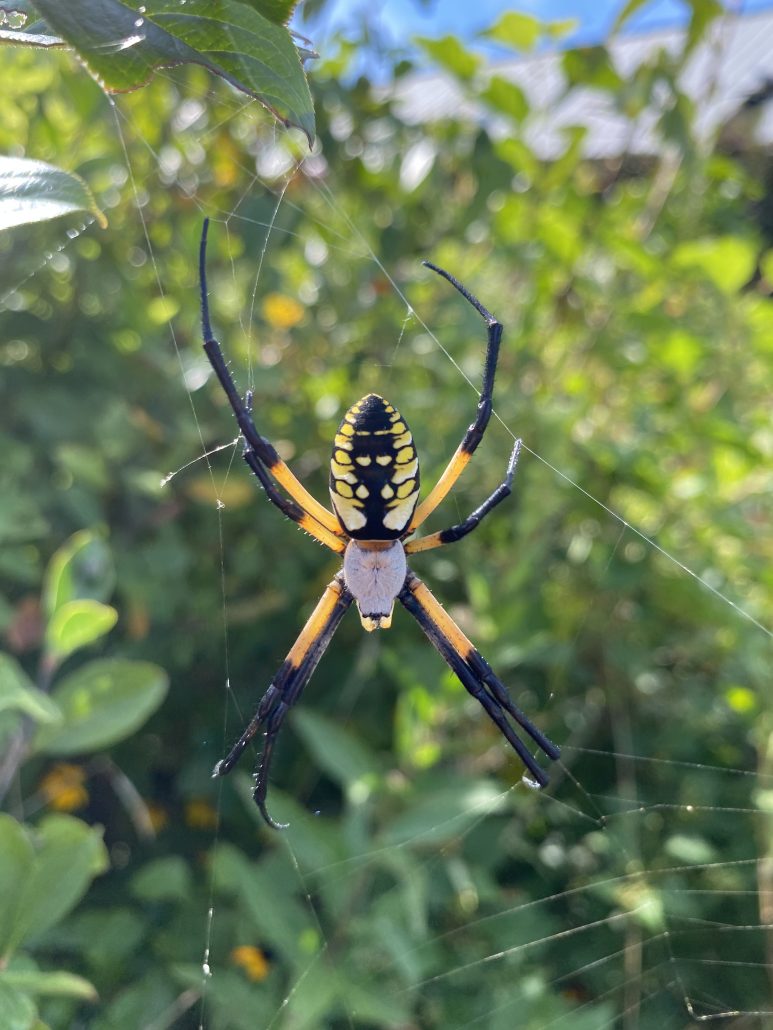By Rick Borchelt

For most people, when their mind turns to spiders, they see images of horror, like Shelob in the “Lord of the Rings” movies and Aragog in the “Harry Potter” franchise. Or they imagine the cloyingly cute (but anatomically incorrect) Charlotte and her heroic antics to save Wilbur the pig from slaughter.

Credit: Rick Borchelt
Autumn, however, is the best time of year to see some of our Maryland spiders up close and personal without the dramatic special effects. For us spider enthusiasts, we have another name for the month: Arachtober, in honor of the Order Arachnida, which includes spiders and their kin!
One of the reasons spiders are so prominent right now is because many of what we think of as typical spiders — the ones who make the beautiful, symmetrical, orb-shaped webs — are maturing, and we can see their webs hanging across shed doors, under porch lights, and over garden or forest paths. Spider webs like these have but one purpose: They are traps, usually for insects.
Each web can contain more than 150 linear feet of spider silk, a protein strand extruded through special glands called spinnerets on the underside of the spider’s belly, glands that add sticky glue to the thread as it plays out. The spiral webs themselves aren’t sticky until the glue is laid on, and a spider keeps some of the main guy lines on the web dry so she doesn’t get caught in her own web.
Most of these big webs — some can be 6 or 8 feet across — are tenanted by a single female spider. For the orbweavers, there’s a great size difference between the male and female; male orbweavers can be less than a tenth the size of the female. This puts him at a serious disadvantage — and in danger of being eaten — when he approaches her on her web to mate. Each orbweaver species has a special courtship signal that the male makes by plucking the strings of the female’s web in a very choreographed way; if he doesn’t do it right, or she’s just not in the mood for it, he’s a snack. If all goes well, though, they’ll mate, and before frost, she’ll deposit dozens or even hundreds of eggs in a leathery silk sack; the eggs will then hatch in the spring. If he wasn’t eaten in the process, the male spider dies shortly after mating; the female spider will also die when her egg laying is done.
A lot of orbweavers are only active at night, hiding in a door jamb or leaf tangle near the web during the day. If the web is damaged by rain or a blundering human, the female will usually simply re-ingest the entire web and start over. Protein like this is very precious and metabolically expensive to make, so eating her web to spin it again makes a lot of sense. At the same time, she’s also swallowing a lot of small gnats, midges and even nutritious pollen grains stuck in the viscous web that were too tiny for her to pounce on and eat the way she does moths and larger flies.
Orbweavers are only one of the many kinds of Maryland spiders. Some studies put the number of spiders in a meadow or hay field at more than one million per acre. Many of these are hunters who don’t spin webs to catch prey, including wolf spiders and jumping spiders that ambush or chase down their victims.
Some spiders build other kinds of webs: Indeed, you can see hundreds of sheet-like webs from funnel weavers and grass spiders in the early morning dew on grassy areas. You’ll typically find the messy tangled webs of house spiders and black widows in dark corners of your garage or basement.
One kind of spider in our area earns the name bolas spider because it spins a sticky silk ball, imbues it with the fake scent of female moths and then slings the ball at male moths who come to investigate.
One web you will not see is that of the Joro spider (Trichonephila clavata), an Asian native now making itself at home in the southern Gulf states. This spider is large, but not much larger than our common yellow garden spider (Argiope aurantia). Even if Joro spiders became established here (which is very unlikely, given our cold winters) they would be harmless, also like the yellow garden spider — to us, anyway. They are only interested in insect prey.
News accounts over the summer predicting hordes of Joro spiders blanketing East Coast suburbia under their webs were simply nonsense. But as Charlotte famously says to Wilbur, “People are very gullible. They’ll believe anything they see in print.”
Or on the web!
##
Have questions for Rick about the world of nature in and around the city, or suggestions for future College Park Wild columns? Drop him a note at rborchelt@gmail.com.







